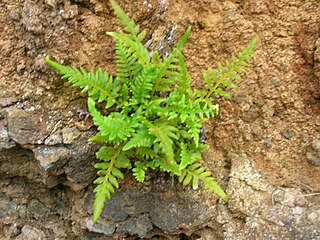
Pteridaceae is a family of ferns in the order Polypodiales, including some 1150 known species in ca 45 genera, divided over five subfamilies. The family includes four groups of genera that are sometimes recognized as separate families: the adiantoid, cheilanthoid, pteridoid, and hemionitidoid ferns. Relationships among these groups remain unclear, and although some recent genetic analyses of the Pteridales suggest that neither the family Pteridaceae nor the major groups within it are all monophyletic, as yet these analyses are insufficiently comprehensive and robust to provide good support for a revision of the order at the family level.

Asclepias californica is a species of milkweed known by the common name California milkweed. It grows throughout lower northern, central and southern California.

Adiantum jordanii is a perennial species of maidenhair fern, in the Vittarioideae subfamily of the Pteridaceae. The species is known by the common name California maidenhair.

Polypodium glycyrrhiza, commonly known as licorice fern, many-footed fern, and sweet root, is a summer deciduous fern native to western North America, where it is found in shaded, damp locations.
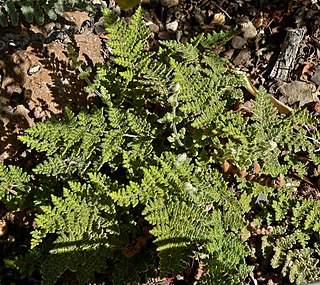
Myriopteris gracilis, formerly known as Cheilanthes feei, is a species of lip fern known by the common name slender lip fern or Fee's lip fern.
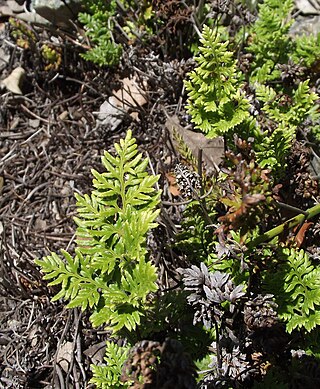
Aspidotis carlotta-halliae is a species of perennial fern known by the common names tufted lacefern and Carlotta Hall's lace fern. It is endemic to California, where it is found in the Central Coast Ranges and coastal hillsides, often on serpentine soils. This species is a fertile hybrid between Aspidotis californica and Aspidotis densa. The fern was named for fern collector Carlotta Case Hall, who coauthored the 1912 botanical guide A Yosemite Flora with her husband, botanist Harvey Monroe Hall.

Aspidotis densa is a species of fern in the Cheilanthoid subfamily, known by the common name Indian's dream or Serpentine fern or dense lace fern. It is native to the west coast of North America from British Columbia to California and east to the Rocky Mountains in Idaho, Montana, and Wyoming; there is a disjunct population on serpentine soils in Quebec.

Myriopteris gracillima, formerly known as Cheilanthes gracillima, is a species of lip fern known by the common name lace lip fern. It is native to western North America, where it grows in rocky habitat from British Columbia to California to Montana.

Myriopteris intertexta, formerly Cheilanthes intertexta, is a species of lip fern known by the common name coastal lip fern. It is native to montane California and western Nevada, Oregon east of the Cascades, and with a disjunct population in central Utah. It grows in dry rocky habitats in sun, typically in rock cracks with little or no soil.
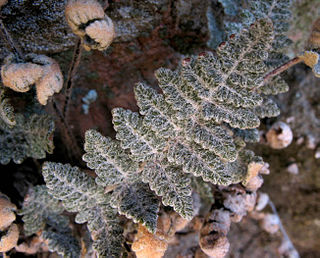
Myriopteris newberryi, formerly Cheilanthes newberryi, is a species of lip fern known by the common name Newberry's lip fern. It is native to southern California and Baja California.
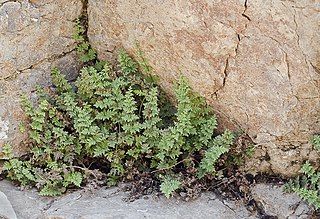
Myriopteris viscida, formerly known as Cheilanthes viscida, is a species of lip fern known by the common names viscid lip fern and viscid lace fern.

Cystopteris fragilis is a species of fern known by the common names brittle bladder-fern and common fragile fern. It can be found worldwide, generally in shady, moist areas. The leaves are up to 30 or 40 centimeters long and are borne on fleshy petioles with few or no long hairs. Each leaf is divided into many pairs of leaflets, each of which is subdivided into lobed segments. The underside of the leaf has many rounded sori containing the sporangia.
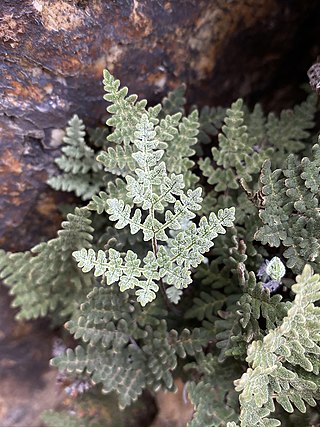
Notholaena californica is a species of fern known by the common name California cloak fern. It is native to southern California and Arizona in the United States, and in adjacent north-western Mexico, where it grows in dry and rocky conditions, often in desert and chaparral habitats.
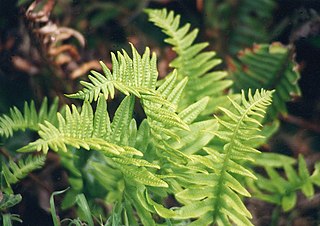
Polypodium californicum is a species of fern known by the common name California polypody.

Polypodium hesperium is a species of fern known by the common name western polypody. It is native to western North America from British Columbia to California, and the Rocky Mountains to northern Mexico, where it grows in rocky habitat types.

Polypodium scouleri is a species of fern known by the common names leathery polypody, Scouler's polypody, coast polypody and leather-leaf fern. It is native to coastal western North America from British Columbia to Guadalupe Island off Baja California. It is a plant of the coastline, growing in cracks on coastal bluffs, in oceanside forests, beach dunes, and similar habitat. It is often affected by heavy fogs and sea spray. This polypody anchors with a waxy, scaly rhizome. It produces triangular or oblong leaves up to 85 centimeters in maximum length and 8 cm width. Each leaf is made up of many round-tipped linear or oblong segments which are usually stiff and leathery in texture and edged with shallow, rounded teeth. The underside of each leaf segment is crowded with rounded sori each up to half a centimeter wide. The sori contain the spores.

Polystichum californicum is a species of fern known by the common name California sword fern. It is native to western North America from British Columbia to California, where it occurs in the coastal mountain ranges and the Cascade Range through the Sierra Nevada. Its habitat includes forest understory and open rocky slopes. This fern produces several arching or erect leaves up to a meter long. Each lance-shaped leaf is made up of many sharp-toothed segments. The undersides bear rounded sori which contain the spores. This fern arose as a hybrid between other Polystichum species and readily forms hybrids of its own.

Polystichum lemmonii is a species of fern known by the common names Lemmon's holly fern and Shasta fern. It is native to western North America from the Sierra Nevada of California north to Washington. It is also known from British Columbia, where there is a single occurrence in the mountains above the Okanagan Valley.
Carlotta Case Hall was an American botanist and university professor who collected and published on ferns. She also co-authored a handbook on the plants of Yosemite National Park.



















